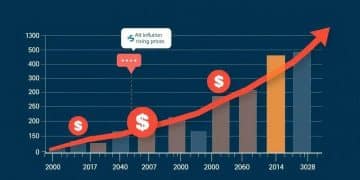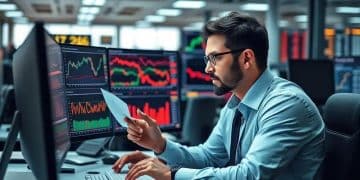US economy: uncovering hidden trends for success

Anúncios
The US economy faces challenges such as rising inflation, supply chain disruptions, and economic inequality, while future predictions point to moderate growth influenced by technological advancements and consumer behavior.
The US economy is constantly evolving, influenced by various factors that may affect your everyday life. Curious about how these economic shifts could shape your financial landscape? Let’s dive into what’s happening.
Anúncios
Current state of the US economy
The current state of the US economy is a topic that affects everyone, from families to large corporations. Recent data shows a mix of growth and challenges, which can impact your financial decisions.
Understanding what’s happening can help you make informed choices. Let’s explore key factors influencing the economy right now.
Indicators of Economic Health
Several important indicators reveal how the economy is performing. The following factors are crucial:
Anúncios
- Gross Domestic Product (GDP): A measure of all goods and services produced.
- Unemployment Rate: A reflection of job availability and labor market strength.
- Inflation Rates: The rate at which prices for goods and services rise.
When GDP grows, it often means businesses are doing well, leading to new job creation. However, if unemployment remains high, many individuals struggle to find work. Keeping an eye on inflation is also vital; too much inflation can erode purchasing power.
Current Economic Trends
In addition to these indicators, certain trends define the economic landscape. For example, technology and innovation are driving growth in sectors like e-commerce and renewable energy.
Consumers are spending more online than ever before. This shift impacts local businesses and supply chains across the nation.
Another important aspect is the Federal Reserve’s policy decisions. Interest rates affect borrowing costs, which in turn influences consumer spending and investment. Lower rates encourage borrowing, while higher rates can stifle growth.
As we navigate these trends, it’s clear that the US economy is constantly changing. Keeping informed about these changes helps everyone understand the potential risks and opportunities ahead.
Key factors driving economic growth

Understanding the key factors driving economic growth is essential to grasp how economies develop and prosper. These elements can shape your financial landscape and influence consumer behavior.
Some of the primary factors include technological innovation, workforce productivity, and government policies, which together create a robust environment for growth.
Technological Innovation
Advances in technology often serve as a catalyst for economic development. New technologies can increase efficiency, reduce costs, and open up new markets. Businesses that embrace innovation typically see significant benefits.
- Automation: Streamlines production and lowers labor costs.
- Digitalization: Enhances access to information and improves decision-making.
- Research and Development: Drives breakthroughs that lead to new products and services.
These advancements lead to job creation and can stimulate further investment in the economy. As businesses adapt, they can respond more effectively to consumer needs.
Workforce Productivity
A skilled and productive workforce is crucial for economic success. Investment in education and training ensures that employees are equipped with the necessary skills to meet market demands.
Furthermore, productivity improvements can increase overall output. When workers are more efficient, businesses can produce more goods and services at a lower cost, benefiting the economy.
Government initiatives aimed at improving education and training programs play a significant role in enhancing workforce quality. These investments ultimately yield a more capable workforce.
Lastly, favorable government policies, such as tax incentives and infrastructure development, can create an environment conducive to growth. By reducing barriers for businesses, governments can promote entrepreneurship and attract investment.
Challenges facing the US economy
The challenges facing the US economy are complex and multi-faceted. Recognizing these obstacles can help individuals and businesses prepare for potential impacts on their financial situations. From inflation to supply chain issues, these challenges require attention and action.
One significant issue is rising inflation. As prices increase, consumers can buy less with the same amount of money. This can lead to decreased spending, which negatively affects businesses and overall economic growth.
Supply Chain Disruptions
Supply chain issues have also emerged as a pressing concern. The pandemic revealed vulnerabilities, causing delays and shortages in various industries. These disruptions can force businesses to adjust their operations or increase prices.
- Labor shortages: Many industries struggle to find enough workers, leading to decreased production.
- Transportation delays: Freight and shipping issues can slow down the delivery of crucial goods.
- Material shortages: Certain materials are hard to find, affecting manufacturing and construction.
Furthermore, changes in consumer behavior also play a role. As people shift their spending habits, businesses must adapt quickly to meet new demands. This adaptability can be challenging for many.
Economic Inequality
Another key challenge is economic inequality. Wealth disparities continue to grow, making it difficult for some individuals to access opportunities for growth. This can lead to social tensions and decreased consumer confidence.
Addressing these challenges requires a collaborative effort between the government, businesses, and communities. By recognizing the issues at hand, society can work towards solutions that promote fairness and stability in the economy.
Future predictions for the US economy

Looking at the future predictions for the US economy can be both exciting and challenging. Understanding potential trends helps both individuals and businesses prepare for what lies ahead.
Experts often analyze various indicators to forecast how the economy might perform. Some common predictions focus on growth rates, inflation trends, and shifts in consumer behavior.
Growth Projections
Many economists predict moderate growth in the coming years. This growth may be influenced by factors such as:
- Technological advancements: Continued innovation can drive productivity and efficiency.
- Consumer spending: The willingness of people to spend can greatly affect the economy.
- Global trade: As international markets stabilize, opportunities for exports may rise.
These factors can create a dynamic environment where businesses can thrive and expand. However, growth is not guaranteed and varies across different sectors.
Inflation and Interest Rates
Inflation rates remain a crucial concern for future predictions. If inflation stays high, the Federal Reserve may raise interest rates to stabilize prices. Higher interest rates can slow economic growth by increasing borrowing costs.
Individuals and businesses will need to adapt to these changes. Managing debt and adjusting spending habits will become increasingly important to maintain financial health.
Forecasting the US economy involves a degree of uncertainty, but staying informed about potential trends allows people to navigate the changing landscape effectively. Keeping an eye on expert analyses and market conditions will help build a clearer picture of the economic future.
FAQ – Frequently Asked Questions about the US Economy
What are the key factors driving economic growth in the US?
Key factors include technological advancements, consumer spending, and global trade. These elements help boost productivity and business expansion.
How does inflation affect consumers?
Inflation leads to higher prices, which means consumers can buy less with the same amount of money, impacting their overall purchasing power.
What challenges does the US economy currently face?
The US economy faces challenges such as rising inflation, supply chain disruptions, and economic inequality, which can slow growth and affect stability.
What predictions are there for the future of the US economy?
Future predictions indicate moderate growth, but factors like inflation control and consumer behavior will significantly influence the economic landscape.






